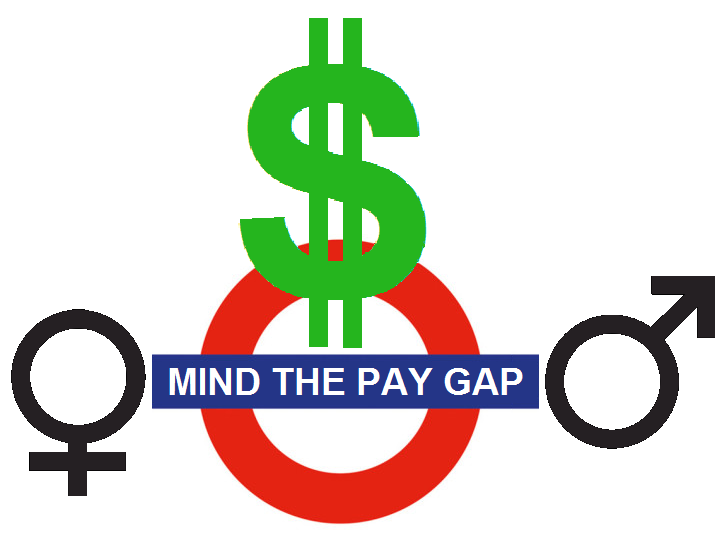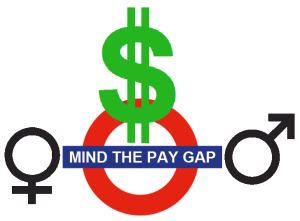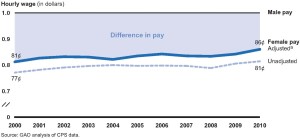Persistent Gender Pay Gap: Is America As Developed As It Thinks It Is?
 "Gender Wage Gap Warning" photo by Mike Licht via Flickr Creative Commons. See the photo in context at: notionscapital.wordpress.com/2014/10/09/mind-the-gap/
"Gender Wage Gap Warning" photo by Mike Licht via Flickr Creative Commons. See the photo in context at: notionscapital.wordpress.com/2014/10/09/mind-the-gap/
While the extent of disparity between the wages of men and women varies by country and by profession, working women everywhere are paid less than their male counterparts. According to the latest Global Gender Report by the WEF, “women are now earning what men did a decade ago” [1] and they can expect to wait “118 years for the economic gap between men and women to close” [2]. In other words, the global pay gap is narrowing at a very slow pace. What is especially alarming is that the U.S. gender pay gap has actually increased in the past year and is currently at 64% [3]. The reality of such crippling discrimination in a country that represents not only the developed world but also a leading world power is a dramatic reminder that the U.S. still has serious progress to make in the protection of human rights.

The reasons behind the gender pay gap are nuanced. It is a complex issue with roots that are entrenched in the culture and the labor market of society. At the same time, while the reasons women are paid less than men for doing the same work might be camouflaged in a variety of factors, at the heart of issue lies rigid societal values and norms. Moreover, the gender pay gap affects not only women but society as a whole; it represents the societal constraint on women’s standard of living and equality which in turn impedes development.
The gender pay gap is a women’s rights issue. It denies women equal rights by subjecting them to unequal pay for the same work as men. This issue can first be analyzed with a feminist perspective. Feminism is an ideology that strives for equal rights and opportunities for women and to eliminate discriminatory practices against them [4]. The gender pay gap serves as evidence to support the feminist view that “all societies are, to varying extents, characterized by patriarchy” [5] because of the double standard it represents in the workplace. The traditional societal values establish gender roles and expectations that explain the patterns of gendered division of careers and of accepted salaries in the labor market. Additionally, the workplace practices and pay systems that allow for employers’ discrimination in the workplace also contribute to the undervaluing of women’s work and skills. The gender pay gap is perpetuating this problem and its consequences in society. Closing the gap would challenge the patriarchal nature of society and largely improve women’s equality.

Secondly, women’s unequal pay is more than only a women’s issue; it is a development issue that affects society as a whole. Development is not purely an economic phenomenon, but a multi-dimensional process involving the reorganization and reorientation of an entire economic and social system [6]. The pay gap between men and women has an economic and also a social effect on women and the rest of society. In other words, it is a hindrance to the development process because, firstly, it strips women of their rights and freedoms to choose, in the words of Amartya Sen’s capability approach [7], and this constrains their well-being.
According to Sen’s capability approach to development, individuals’ cultivation of capabilities and consequential expansion of choices that are critical to a sustainable human well-being are only achievable after the necessary resources have been provided [8]. In this sense, the gender pay gap restricts the freedoms of women by providing them with less income than their male counterparts and denying their human right to gender equality. As a result, the well-being of society as a whole suffers because women are not able to invest as much in their children and families. Moreover, a lower income for women means that women are spending less and therefore less money is going back into the economy, restricting economic growth. Similar to the feminist perspective on the issue, a development perspective suggests that closing the gender pay gap would be a necessary step in changing the nature of society to achieve better equality and standard of living for everyone.
In conclusion, this gender-based economic disparity serves as a tangible reflection of the systemic gender-based discrimination that pervades many aspects of society. The gender pay gap is an issue of women’s equality as well as an issue of development. In the developed world of today, it is unreasonable that gendered disparity in wages is a still a reality. This regressive social norm needs to be changed.
Works Cited
[1] Ivana, I. (2015, November 18). U.S. gender pay gap is getting worse. Retrieved November 18, 2015, from http://money.cnn.com/2015/11/18/news/gender-pay-gap/
[2] Ibid.
[3] Ibid.
[4] Mintz, E., Close, D., & Croci, O. (2013). Politics, Power, and the Common Good: An Introduction to Political Science (Fourth ed.). Upper Saddle River, New Jersey: Pearson Education.
[5] Ibid.
[6] Balan, M. (2015, November 16). Development.
[7] For more information, check here: http://www.ophi.org.uk/wp-content/uploads/OPHI-HDCA-SS11-Intro-to-the-Capability-Approach-SA.pdf
[8] Haslam, Paul Alexander., Jessica Schafer, and Pierre Beaudet. “Chapter 1.” Introduction to International Development: Approaches, Actors, and Issues. Second ed. Ontario: Oxford UP, 2009. 14. Print.
